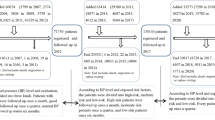Abstract
Hypertension is the most important single modifiable risk factor of stroke. The purpose of this study was to investigate the distribution patterns of risk factors of stroke and 10-year probability of stroke in hypertensive patients visiting community-based hospitals. A total of 1088 hypertensive patients who visited 61 community-based hospitals nationwide were enrolled. Risk factors of stroke were evaluated using a series of laboratory tests and physical examinations, and the 10-year probability of stroke was determined by applying the Framingham stroke risk equation. The proportion of patients who have uncontrolled hypertension despite the use of antihypertensives was 63.3% (59.6% women, 68.7% men; P=0.006). The average 10-year probability of stroke in hypertensive patients was 16.05% (14.68% women, 17.99% men; P<0.001). The 10-year probability of stroke in patients with hypertension gradually increased in proportion to age. In patients treated with antihypertensives, 10-year probability of stroke gradually increased in proportion to blood pressure. The 10-year risk of stroke in hypertensive patients was approximately 4.6 times higher than that of stroke in the general population. In conclusion, as the 10-year risk of stroke in hypertensive patients was approximately 4.6 times higher than that of stroke in the general population, more aggressive interventions are needed to reduce blood pressure and stroke risk in hypertensive patients.
This is a preview of subscription content, access via your institution
Access options
Subscribe to this journal
Receive 12 digital issues and online access to articles
$119.00 per year
only $9.92 per issue
Buy this article
- Purchase on Springer Link
- Instant access to full article PDF
Prices may be subject to local taxes which are calculated during checkout




Similar content being viewed by others
References
Korea National Statistical Office. Year Book of Cause of Death, 2004.
National Health Insurance Corporation. 2005 National Health Insurance Statistical Yearbook Seoul Korea. Health Insurance Review Agency and National Health Insurance corporation 2006.
Andrawes WF, Bussy C, Belmin J . Prevention of cardiovascular events in elderly people. Drugs Aging 2005; 22: 859–876.
Kim JS, Yoon SS . Perspectives of stroke in persons living in Seoul, South Korea. A survey of 1000 subjects. Stroke 1997; 28: 1165–1169.
Kannel WB, Wolf PA, Verter J, McNamara PM . Assessment of the role of blood pressure in stroke; the Framingham Study. JAMA 1996; 276: 1269–1278.
Lewington S, Clarke R, Qizilbash N, Peto R, Collins R, Prospective Studies Collaboration. Age-specific relevance of usual blood pressure to vascular mortality: a meta-analysis of individual data for one million adults in 61 prospective studies. Lancet 2002; 360: 1903–1913.
Wolf PA, D′Agostino RB, Belanger AJ, Kannel WB . Probability of stroke: a risk profile from the Framingham Study. Stroke 1991; 22: 312–318.
Kannel WB, Wolf PA, McGee DL, Dawber TR, McNamara P, Castelli WP . Systolic blood pressure, arterial rigidity and risk of stroke: The Framingham Study. JAMA 1981; 245: 1225–1229.
Lassen NA . Epidemiologic assessment of the role of blood pressure in stroke. JAMA 1996; 276: 1269–1278.
Jee SH, Park JW, Lee SY, Nam BH, Ryu HG, Kim SY et al. Stroke risk prediction model: a risk profile from the Korean study. Atherosclerosis 197 (1): 318–325.
Chobanian AV, Bakris GL, Black HR, Cushman WC, Green LA, Izzo Jr JL et al. The Seventh Report of the Joint National Committee on Prevention, Detection, Evaluation, and Treatment of High Blood Pressure: the JNC 7 report. J Am Med Assoc 2003; 289: 2560–2572.
Molloy TJ, Okin PM, Devereux RB, Kligfield P . Electrocardiographic detection of left ventricular hypertrophy by the simple QRS voltage-duration product. J Am Coll Cardiol 1992; 20: 1180–1186.
Okin PM, Roman MJ, Devereux RB, Kligfield P . Electrocardiographic identification of increased left ventricular mass by simple voltage-duration products. J Am Coll Cardiol 1995; 25: 417–423.
Sokolow M, Lyon TP . The ventricular complex in left ventricular hypertrophy as obtained by unipolar precordial and limb leads. Am Heart J 1949; 37: 161–186.
Ministry of Korea Health and Welfare. 2003 The Korean National Health and Nutrition Examination Survey 2005.
Dahlöf B, Devereux RB, Kjeldsen SE, Julius S, Beevers G, de Faire U, et al., LIFE Study Group. Cardiovascular morbidity and mortality in the Losartan Intervention For Endpoint reduction in hypertension study (LIFE): a randomised trial against atenolol. Lancet 2002; 359: 995–1003.
Gu Q, Paulose-Ram R, Dillon C, Burt V . Antihypertensive medication use among US adults with hypertension. Circulation 2006; 113: 213–221.
Acknowledgements
This study was supported by MSD Korea and Seoul R&BD Program (10526).
Author information
Authors and Affiliations
Consortia
Corresponding author
Rights and permissions
About this article
Cite this article
Park, C., Choi, C. & STROKE Study Group. Probability of stroke in Korean hypertensive patients visiting community-based hospitals: using a risk profile from the Framingham study. J Hum Hypertens 23, 252–258 (2009). https://doi.org/10.1038/jhh.2008.128
Received:
Revised:
Accepted:
Published:
Issue Date:
DOI: https://doi.org/10.1038/jhh.2008.128
Keywords
This article is cited by
-
Comparing the probability of stroke by the Framingham risk score in hypertensive Korean patients visiting private clinics and tertiary hospitals
BMC Neurology (2010)
-
Estimating the probability of stroke in Korean hypertensive patients visiting tertiary hospitals using a risk profile from the framingham study
BMC Neurology (2009)



